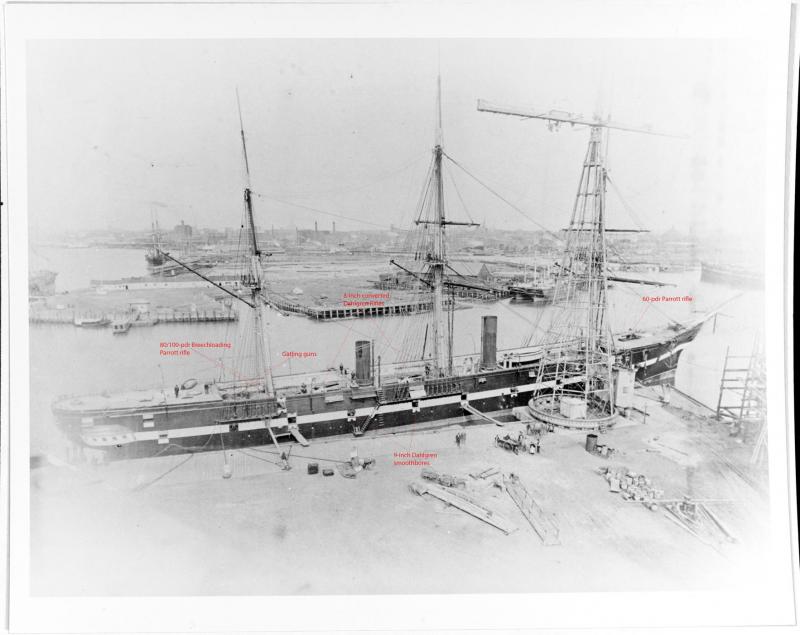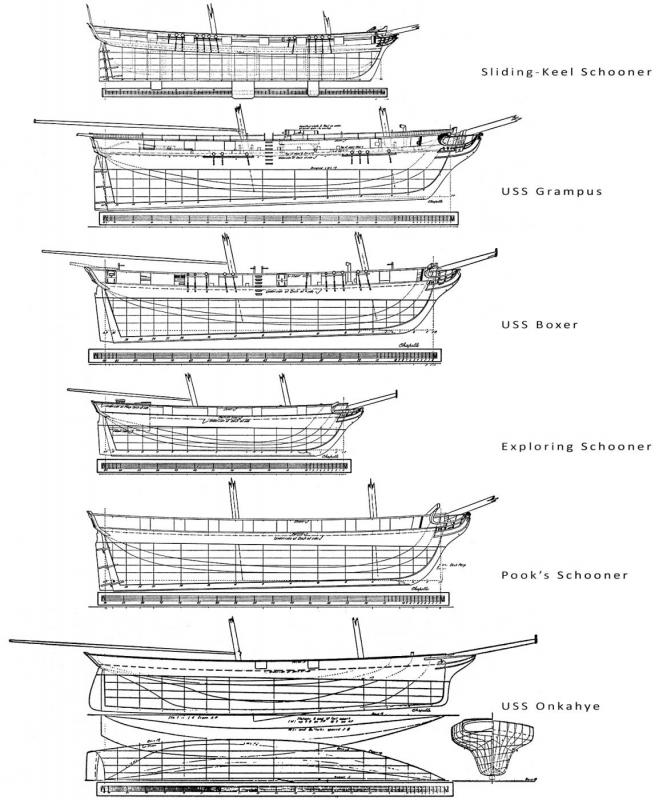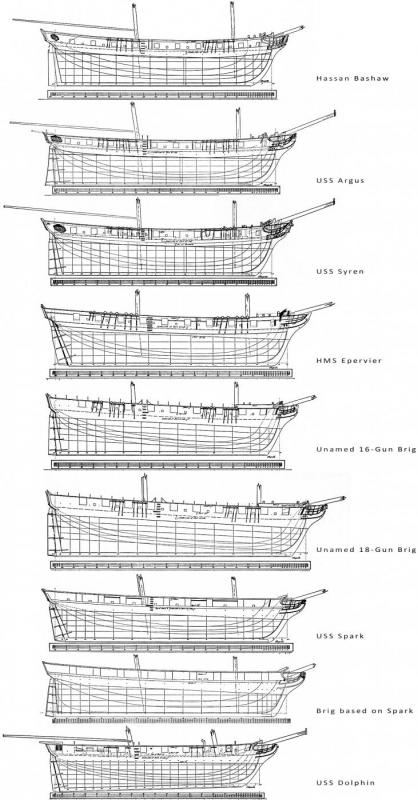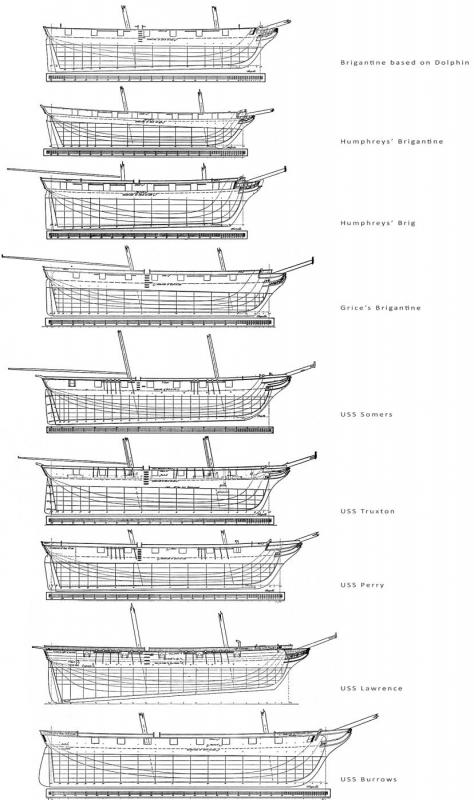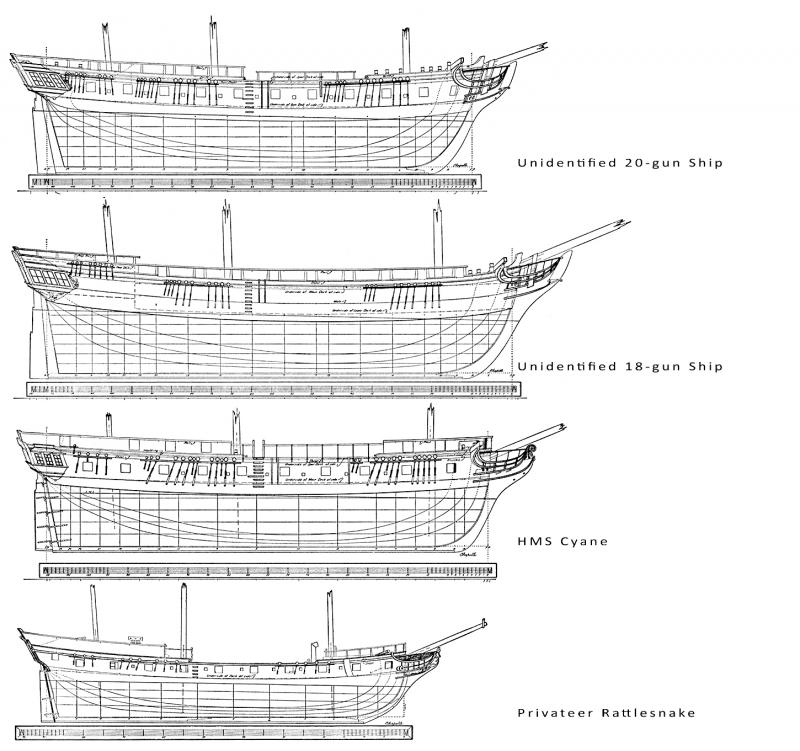
Talos
Members-
Posts
413 -
Joined
-
Last visited
Content Type
Profiles
Forums
Gallery
Events
Everything posted by Talos
-
I always thought that was to make him less "Navy-like" and more of a land-lubber, instead of wearing blue or red like a sailor or Marine.
-
A first look at the Frigate John Adams, 1799-1829
Talos replied to Talos's topic in Nautical/Naval History
I need to get back to work on the JA. I haven't touched it in a while, including the razee and jackass versions. -
"Gunnery notes" from William Rivers (*1755, †1817)
Talos replied to dafi's topic in Nautical/Naval History
Looks like: "The Victory had white hammock cloth spread loosely over the (others) and kept that (until she) commenced firing." to me. -
That definitely sounds to me like someone from shore doing a model. The parts he'd be able to see would be pretty accurate, the parts he can't, including the deck fittings and birds-eye view of the bridge, would be much less or absent entirely, The guns make sense too, the gunports would be a lot more visible than the guns (or lack thereof) in them. Then of course the usual exaggeration in details and proportions from an amateur (as in not a naval architect)'s hands. It's a very neat model. I'm glad I can help in any small way. I love the ships and the design and history of them, so doing the research was fun for me. I don't mind it!
-
I decided to annotate one of the pictures of Tennessee with the guns that are visible. This looks to be the armament configuration mtaylor gave, missing the two extra larger Parrotts it had at other times.
-
I could see that being the case, sure. This might help with scaling the guns, it's a diagram of the space the different guns need. For your purposes, the IX-inch Dahlgrens are on the gun deck, the 8" converted rifles are the XI-inch iron carriages, and the 80-pdr Parrott breechloaders are the 100pdrs on this.
-
Tennessee, as refit, had a gundeck of 9" Dahlgrens. The two 8" rifles are converted smoothbore XI-inch Dahlgrens and were placed fore and aft on pivots. You can see the aft pivot rifled Dahlgren in the picture of the band mustered with their helmets on and the saber drill. Four 80-pdr converted breechloading Parrotts were in the broadside ports, two per side. She also carried four spar torpedoes and four Hotchkiss 1.5" breechloaders.
-
I have these few, and in much higher resolution than these pictures. An example of the full-size is located after the Imgur link the gallery is in. Lots of details of the deck fittings. http://imgur.com/a/Rj7xn https://www.history.navy.mil/bin/imageDownload?image=/content/dam/nhhc/our-collections/photography/images/NH%2072000/NH%2072844&rendition=original
-
American sailing warships with no plans or records
Talos replied to CharlieZardoz's topic in Nautical/Naval History
You also have the problem of finding enough commands for the higher ranking officers too. Can't have a Captain commanding a brig, after all. But certainly a large part of it is small fleet syndrome: they'll never have the numerical advantage, so each hull has to be as useful and powerful in that class as they can be. That's a big part of the reason for the 44s in the first place.- 401 replies
-
- John Adams
- Alliance
-
(and 3 more)
Tagged with:
-
American sailing warships with no plans or records
Talos replied to CharlieZardoz's topic in Nautical/Naval History
Grampus is a favorite of mine, I love her lines. Such an elegant schooner. As far as Boxer and her sisters, they were all converted into brigs. Heavily overloaded with guns and boats, they had a large sail area and were considered tender, but good sailors. That was the case of most of the late US brigs, which all were extreme designs. Two even were lost to capsizing. The Navy never really loved the schooner rig. They tended to buy them when needed and get rid of them quickly. There was always a surge of popularity around wartime, like the War of 1812, but they didn't last long after that. Several were converted to brigs, like Enterprise, Vixen, and Boxer, while others were simply gotten rid of, or lost (they had a higher loss rate than the larger ships). While the brig has several advantages over the schooner, including better performance on a wider range of wind directions, much better ability to cope with battle damage, and more maneuverability, I get the feeling that to the USN, the schooner was never a "proper" navy design. The Navy wasn't really much for small ships anyway, instead purchasing many of them for a specific mission, like the Anti-piracy operations in the Carribean, or anti-slavery patrols for the Africa Squadron (this mission was done by the naval construction ones instead). By the time you get to the 1830s-1840s, the sloop (which has grown larger and larger) is the backbone of the US Navy alongside the heavy frigates of the Brandywine class, pushing out schooners and brigs from above.- 401 replies
-
- John Adams
- Alliance
-
(and 3 more)
Tagged with:
-
American sailing warships with no plans or records
Talos replied to CharlieZardoz's topic in Nautical/Naval History
Well yes, multiple ships with the same name. In any case, as the 1831 Boxer was built as a schooner, I had her on the schooner sheet (just like Vixen). EDIT: That top plan you have is likely Enterprise. Chapelle notes some differences from Boxer, including the missing molding under the gunports and the lack of curved rail coming from the head to the knightheads. The closer one to Humphreys' design for Boxer (while not being an exact ancestor) is his 88' brigantine (in my sheet it's the one after the Brigantine based on Dolphin), which was one of a number of small sip designs he made, including studies of schooners between 100' down to 88'. That Brigantine based on Dolphin is just a simple lengthening of the brig, but it features the correct body plan Dolphin was built to, not the original lines visible in the plans.- 401 replies
-
- John Adams
- Alliance
-
(and 3 more)
Tagged with:
-
American sailing warships with no plans or records
Talos replied to CharlieZardoz's topic in Nautical/Naval History
I typed the last without my references. Chapelle thought that the unnamed 16-gun brig is Boxer, while the 18-gun was the plans for Saranac and Chippewa, as both were said to have two more guns than their ratings (14 and 16 guns respectively), without filling the bridle ports. These would be powerful brigs, with a pair of long 18s, long 12s, and the rest of their guns being 32-pdr carronades. Sailed well, but they were made of green timber and rotted very quickly.- 401 replies
-
- John Adams
- Alliance
-
(and 3 more)
Tagged with:
-
American sailing warships with no plans or records
Talos replied to CharlieZardoz's topic in Nautical/Naval History
I...crap, in my overzealous quest to even the two sheets, I must have missed it. I'll update the sheets later and add it. As far as I know, none of the proposed brigs were built, the USN doing it's normal neglect of small ships. I've been busy and totally slacked on John Adams. Did other ones recently, completing the Bittern Crane, the original Macedonian, Epervier, a gun brig, revenue cutter Morris, and doing work on the second Macedonian, Brandywine, Sabine/Santee, and a few odds and ends. EDIT: Oh, wait Boxer (as in the later one) is on one of my schooner sheets.- 401 replies
-
- John Adams
- Alliance
-
(and 3 more)
Tagged with:
-
American sailing warships with no plans or records
Talos replied to CharlieZardoz's topic in Nautical/Naval History
Brigs I actually already have you covered. I did two of them, one sheet for the 1830s ships, one for the older ones. The one I'm most fascinated by is the unbuilt USS Burrows, a large, late brig, over 120 feet long. I'll compare some of the frigate body plans later since I can overlay them easily.- 401 replies
-
- John Adams
- Alliance
-
(and 3 more)
Tagged with:
-
American sailing warships with no plans or records
Talos replied to CharlieZardoz's topic in Nautical/Naval History
Well, Chapelle was guessing that the 20-gun ship is an improved version of Maryland and Patapsco, soooo..... Merrimack should be pretty easy to do a generic Federal frigate of the era on her dimensions. I'm not sure on the other ships since I have to do some research on them first. And yeah, I do the diagrams because it adds a lot to me too. Really puts things in perspective and makes it easy to compare. If there's any particular ships through Chapelle's books that you want to see lined up, let me know, I have many of them scanned already.- 401 replies
-
- John Adams
- Alliance
-
(and 3 more)
Tagged with:
-
American sailing warships with no plans or records
Talos replied to CharlieZardoz's topic in Nautical/Naval History
I’ve been fascinated with those two particular plans for a while. I included them in one of my profile comparisons, alongside the privateer Rattlesnake and the (incorrect!) Cyane. The 18-gun one is just so weird, compared to the warships I’m used to seeing. More merchant-like for sure, but still too sharp to be a civilian one, too big for an illegal trader. Chapelle argues that she must be a naval or merchant-cruiser. He also suggests that it was a design by Fox because of the nature of her stem. As far as the 20, it’s got the appearance of the typical American frigates of the era. Looking at the plans of John Adams and this ship, they’re virtually identical above the waterline except for size. Chapelle suggests that it was a design for an improved version of Maryland and Patapsco, nearly identical dimensions but with fewer guns and higher gunports to correct the guns on the earlier ships being very low. He also compares the ship to the Brazen-class Cyane post ship, which had more guns on the main deck, but 6pdrs instead of 9pdrs, and was the better sailor because it wasn't as overloaded until the War of 1812 when it carried 32 guns instead. I’ve pointed it out before, but I will again, but Chapelle got the wrong Cyane plans when he sent for them. The ones in the book are the older 18-gun Bittern-class sloop Cyane, not the 26-gun Brazen-class Cyane the Americans captured. Thinking it was the War of 1812 ship, he refitted the drawing with solid bulwarks like most ships of the era received. That’s the plan I have in the comparison I’m linking. As far as the other ships go, Chapelle points out that everything in this era down to sloops tended to be shrunken versions of the 44s, at least above-water style-wise. You can see that comparing John Adams and the 20-gun ship. As long as you get the proportions and dimensions right, you can probably do a fair amount basing off of the 20-gun, Constitution/Constellation/Chesapeake, and the Philly, New York, Boston, and Essex.- 401 replies
-
- John Adams
- Alliance
-
(and 3 more)
Tagged with:
-
Seeking information on determining load waterline
Talos replied to trippwj's topic in Nautical/Naval History
Really interesting stuff. I wonder, looking at the table, if some of the difference might be in the construction of the hulls, since the other three examples are all ships of the line. Is there a 32 or 36-gun frigate from the 19th century you might be able to compare it to? That'd be pretty close in class to the 30-gun of 1764. -
Crosspost from the American Sailing Warships thread and not big history or anything, but the receiving ship Independence, a razee'd 74, in drydock in Mare Island, San Francisco 130 years ago today.
-
American sailing warships with no plans or records
Talos replied to CharlieZardoz's topic in Nautical/Naval History
A hundred and thirty years ago today, USS Independence was in dry dock at Mare Island. She had been floated in on October 30th. Nearly thirty years later, in 1915, she was burned and scrapped. This is an interesting interior view of her during her time as a receiving ship in Mare Island. Note the truss of the large roof built over her, as well as the hammocks stored in the hammock rails and the three light guns in the gun ports. I believe they are Hotchkiss Revolving Cannons, probably in 37mm. A nice color shot of her after they painted her light grey. She wasn’t the only receiving ship to be painted this way, USS Dale was as well. A nice shot of her stern to round things out. This gives a good look at the molding on her stern and quarter galleries as well as the laurel wreath badges. It also illustrates an interesting quirk in the design. The quarter galleries aren’t level with the upper deck. Rather, they’re placed half a deck lower, which you can see compared to the eight (8!) stern chase ports. As I haven’t seen this on any of the other liners, and the sail plan of Independence shows them lined up with the decks, I believe it’s a result of the razee-ing process. They probably looked awkward so high up, especially compared to normal US frigates which carried them below the level of the spar deck.- 401 replies
-
- John Adams
- Alliance
-
(and 3 more)
Tagged with:
-
American sailing warships with no plans or records
Talos replied to CharlieZardoz's topic in Nautical/Naval History
Actually, Santee was built with the pivots too. You can see her aft and forward pivot ports in various pictures. Silverstone lists her as being armed from the start with 64-pounder shot and shell guns fore and aft. These were the biggest guns in the inventory by weight at the time, weight 20 cwt more than the early, weak 10” (not the Dahlgren, the Paixhan’s -style gun), 106 cwt total. The X-inch Dahlgren, at least the original model of it, weighs just slightly more at 107 cwt. I did a drawing of it which you can see on the previous page of this thread. It was that big to enable it to fire solid shot, double-shot the gun, etc. The lighter shell guns of the same caliber (8”) were intended to mostly fire the lighter shells, though they could fire solid shot in a pinch if they had to. The 64-pdrs were limited to only a few ships, mostly these and the paddle-wheel steamers where they needed the extra punch to make up for the lack of guns due to the paddle boxes. Speaking of paddle-wheelers, the bridge on Sabine in those pictures is called a flying bridge. They were an evolution of a bridge structure placed between the wheels of a side-wheeler where a Captain could have a good view. Previously Captains had their spot at the quarterdeck so they could see all of their rigging and sails clearly, but this was becoming less important with steamers. Flying bridges were getting popular in the Civil War era, you can see them on a variety of vessels, including steam sloops and gunboats. With regards to the poop deck and aft pivot gun, that decking is not robust enough to take a X-inch Dahlgren’s weight and recoil. You’ll also notice the dark band on the mast right about level with the railing. That’s where the spanker boom attaches to the mast, there’s zero room for a cannon under it, it’s waist high. The last shot you have is indeed one of Santee when she’s a training ship armed with X-inch Dahlgrens fore and aft and a set of VIII-inch Dahlgrens on her upper deck (plus it looks like a Parrott up front). In this uncropped version of the picture, you can see the pivot wheels for the aft pivot resting on the deck. Also look all the way in front behind the Parrot and you can see the interior of Santee’s forward pivot port. Interestingly, this shot of Santee roofed over only shows the rear pivot port (the double-wide window aft) and blank planking up front. I imagine they replanked that area because the forward pivot port would be a long, structurally weak part to mount the roof on. Here’s a shot of Santee (left) and Constitution during the War. Santee’s forward pivot port is open. https://www.loc.gov/resource/ppmsca.33945/ Found this while I was looking up information today. Apparently one of Sabine’s 6.4” (100-pounder) Parrott Rifles survives in Michigan as a monument. http://www.hmdb.org/marker.asp?marker=98250 She might even be the large Parrott rifle we see sticking out of Sabine’s aft pivot port in this picture. http://www.loc.gov/pictures/resource/cwpb.03821/ (be sure to download the full-size picture to zoom in. Also note the Royal Navy paddle-wheeled warship back there with the boats on top of the boxes and that very distinctive mid-century Royal Navy quarter gallery and stern design. You can also see guys standing on Sabine’s flying bridge in that picture, helping you to place it exactly) Random unrelated picture of Saratoga I came across today too.- 401 replies
-
- John Adams
- Alliance
-
(and 3 more)
Tagged with:
-
American sailing warships with no plans or records
Talos replied to CharlieZardoz's topic in Nautical/Naval History
Glad I could help. If you have more questions, please do ask. I enjoy the discussion and the research, it's a lot of fun. Also very glad to see the billethead survived, especially after finding that picture of it mounted on a building at the shipyard. Is it in an indoor or outdoor display?- 401 replies
-
- John Adams
- Alliance
-
(and 3 more)
Tagged with:
-
Cruizer-class Brig-Sloops of the Royal Navy
Talos replied to molasses's topic in Nautical/Naval History
His forward-looking school certainly explains why it looked late 19th century. The first edition of that book dates back to 1829, back when he was Superindentent of the School of Naval Architecture and three years before it closed in 1832. That whole era is interesting to me too. D.K. Brown's Before the Ironclad, which covers the post-Napoelonic War part of that era got me into it, and also had me looking at the earlier part during the wars, with people like Bentham. Brown talks a lot about Seppings and Symonds though, though he isn't (and I agree) a big fan of Symonds. -
Cruizer-class Brig-Sloops of the Royal Navy
Talos replied to molasses's topic in Nautical/Naval History
Looked it up, it was Fincham's Treatise on Masting Ships. My specific source I used was the 2nd edition of 1843 as found on Google Books. https://books.google.com/books?id=z4QhGFh-7ZwC&dq=Fincham's%20Treatise%20on%20Masting%20Ships&pg=PA88#v=onepage&q&f=falsePage 88, the first and second examples, which match the length and beam of Cruizer and Cherokee brigs. -
Cruizer-class Brig-Sloops of the Royal Navy
Talos replied to molasses's topic in Nautical/Naval History
I agree with this. Some comments on the points: The initial Cruizer and Snake prototypes were ordered in 1796 and completed in 1798 under Earl Spencer’s board. One of the other projects Spencer did was give eight different 74-gun 3rd Rate contracts to various private yards. No more Cruizers were ordered until 1801 when they needed them. A concern, but the UK running out of oak is an exaggerated myth. The real problem was supplies were getting harder to procure at a price the admiralty wanted to pay, and they let the reserves dwindle and for a few years their supplies were tight. By the end of the war they had plenty again though prices were still above pre-war levels. The more acute shortages were in difficult pieces, like knees. The Cruizer and Snake were designed before there was any wartime production crunch, so they were hardly austere designs. Fully worked-out designs to all naval standards, designed for global operations anywhere the Royal Navy was and they took their time with it. They really were in a sweet spot between capability and economy, as were the Cherokees after them. Incidentally, the part that screams cutter to me the most is that little sheer by the bow, which doesn’t match the deck line. Nothing wrong with being inspired by cutter designs. Those were the UK’s most notoriously seaworthy small craft, coastal vessels designed for channel work and the like. This, not a timber shortage, was the real problem. So few ships were sailing at their proper, rated complements all the time, most had larger proportions of pressed landsmen and long overseas deployments and brutal blockade periods both wore down what crews they did scrounge together. Cruizer’s crew size was typical of both ship and brig sloops of her size. Even HMS Peacock (ex-USS Wasp) had an identically rated crew of 121 in British service and Swan only had four extra men under older crew regulations, and 121 after 1794. Between the 32-pounder carronades (which were also added to small post ships like Cyane) giving a heavier armament for their size, while still being large enough for proper ocean sailing and deployment, they were very versatile craft. They weren’t particularly designed for economy so much as being a standard and modern design in an economical size class (compared to all the older quarterdeck sloops based on designs dating back decades). -
Cruizer-class Brig-Sloops of the Royal Navy
Talos replied to molasses's topic in Nautical/Naval History
Almost four feet shorter (96'7" versus 100 feet) /and/ 26'9" versus 30'6" wide Cruizers. Judging by the plans for Swan in the RMG, she looks shallower too despite having nearly the same rated draft. So it really doesn't surprise me that they would be nearly a hundred tons apart using Builder's Old Measurement, where a shift in beam can cause a large shift in size.
About us
Modelshipworld - Advancing Ship Modeling through Research
SSL Secured
Your security is important for us so this Website is SSL-Secured
NRG Mailing Address
Nautical Research Guild
237 South Lincoln Street
Westmont IL, 60559-1917
Model Ship World ® and the MSW logo are Registered Trademarks, and belong to the Nautical Research Guild (United States Patent and Trademark Office: No. 6,929,264 & No. 6,929,274, registered Dec. 20, 2022)
Helpful Links
About the NRG
If you enjoy building ship models that are historically accurate as well as beautiful, then The Nautical Research Guild (NRG) is just right for you.
The Guild is a non-profit educational organization whose mission is to “Advance Ship Modeling Through Research”. We provide support to our members in their efforts to raise the quality of their model ships.
The Nautical Research Guild has published our world-renowned quarterly magazine, The Nautical Research Journal, since 1955. The pages of the Journal are full of articles by accomplished ship modelers who show you how they create those exquisite details on their models, and by maritime historians who show you the correct details to build. The Journal is available in both print and digital editions. Go to the NRG web site (www.thenrg.org) to download a complimentary digital copy of the Journal. The NRG also publishes plan sets, books and compilations of back issues of the Journal and the former Ships in Scale and Model Ship Builder magazines.


